小学英文优秀说课稿
小学英语万能说课稿(优秀3篇)
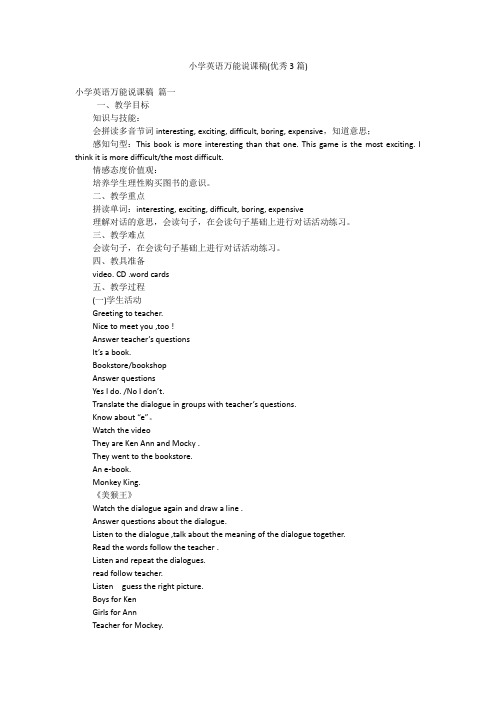
小学英语万能说课稿(优秀3篇)小学英语万能说课稿篇一一、教学目标知识与技能:会拼读多音节词interesting, exciting, difficult, boring, expensive,知道意思;感知句型:This book is more interesting than that one. This game is the most exciting. I think it is more difficult/the most difficult.情感态度价值观:培养学生理性购买图书的意识。
二、教学重点拼读单词:interesting, exciting, difficult, boring, expensive理解对话的意思,会读句子,在会读句子基础上进行对话活动练习。
三、教学难点会读句子,在会读句子基础上进行对话活动练习。
四、教具准备video. CD .word cards五、教学过程(一)学生活动Greeting to teacher.Nice to meet you ,too !Answer teacher’s questionsIt’s a book.Bookstore/bookshopAnswer questionsYes I do. /No I don’t.Translate the dialogue in groups with teacher’s questions.Know about “e”。
Watch the videoThey are Ken Ann and Mocky .They went to the bookstore.An e-book.Monkey King.《美猴王》Watch the dialogue again and draw a line .Answer questions about the dialogue.Listen to the dialogue ,talk about the meaning of the dialogue together.Read the words follow the teacher .Listen and repeat the dialogues.read follow teacher.Listen guess the right picture.Boys for KenGirls for AnnTeacher for Mockey.Act the story in groups.(二)教师活动一:Warming upGreetingNice to meet you!二:Language preparation1 Show a English books askWhat’s this? It’s a ________.We can buy it in _________.Do you like English book/music book/story book/ic book ?2 For the titleToday we will learn “Buying e-book”。
小学英语说课稿模板(6篇)
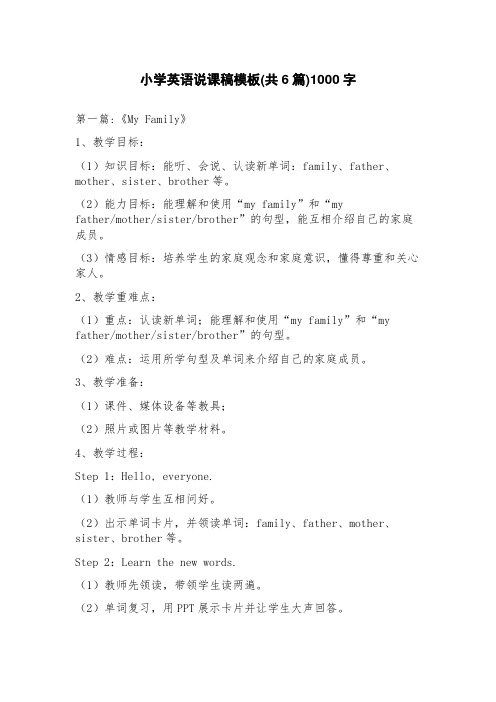
小学英语说课稿模板(共6篇)1000字第一篇:《My Family》1、教学目标:(1)知识目标:能听、会说、认读新单词:family、father、mother、sister、brother等。
(2)能力目标:能理解和使用“my family”和“myfather/mother/sister/brother”的句型,能互相介绍自己的家庭成员。
(3)情感目标:培养学生的家庭观念和家庭意识,懂得尊重和关心家人。
2、教学重难点:(1)重点:认读新单词;能理解和使用“my family”和“my father/mother/sister/brother”的句型。
(2)难点:运用所学句型及单词来介绍自己的家庭成员。
3、教学准备:(1)课件、媒体设备等教具;(2)照片或图片等教学材料。
4、教学过程:Step 1:Hello, everyone.(1)教师与学生互相问好。
(2)出示单词卡片,并领读单词:family、father、mother、sister、brother等。
Step 2:Learn the new words.(1)教师先领读,带领学生读两遍。
(2)单词复习,用PPT展示卡片并让学生大声回答。
(3)复习过后,教师出一些新单词的图片,让学生猜测单词,并引导学生说出新单词。
Step 3:Introduce my family.(1)出示自己家庭照片。
(2)教师介绍自己的家庭成员,并介绍爸爸、妈妈、姐姐、弟弟、哥哥这几个词的意思。
(3)学生模仿教师介绍自己的家庭成员,用“My family has …”或“My father/mother/sister/brother is …”进行介绍。
(4)教师给出评价和指导。
Step 4:Listen and repeat.(1)语音练习:听发音,跟读单词和句子。
(2)教师播放听力材料,学生跟读练习。
Step 5:Homework(1)写一段50字左右关于自己家庭的介绍。
小学人教版的英语说课稿(10篇)

小学人教版的英语说课稿(10篇)小学的英语说课稿篇1【教材分析】我说课的内容是 How are you? 第一课时,Let’s talk 中的前四个情景。
本节课是对话课,对话课是单元整体教学的重要环节。
本课的重点交际用语是“How are you?”及其答语。
本节课是对话教学。
通过小熊早上出去,遇见长辈一个个问好,引入话题,先短后长,不仅出现了各种答语,还复习了以前学过的问候语。
对儿童有文明礼貌的教育意义。
【教学目标】《英语课程标准》指出:激发和培养学生学习英语的兴趣,使学生树立自信心,养成良好的学习习惯和形成有效的学习策略,发展学生自主学习的能力和合作精神是小学英语教学的基本任务。
在认真分析教材的基础上,我针对学生实际,将本课时的教学目标确定如下:1、知识目标(1) 使学生能认读单词:fine, OK, bird, pig, fox, hen(2) 使学生掌握与熟人打招呼的句型: How are you?I’m fine. I’m OK.Thank you. And you?2、语言技能目标:在图文或场景下进行简单的英语交流和表演,培养学生灵活运用所学知识进行交流的能力.3、情感态度目标通过本课的学习,学生对英语听说感兴趣,背诵歌谣,做游戏,敢说,乐于模仿,在鼓励评价中树立自信。
在小组活动中积极参与合作,从而认识到交流在英语学习中的重要性。
4、文化意识目标:能够恰当使用英语中与人问好的问候语,了解在英语国家中熟人见面相互打招呼的方式。
对学生进行日常行为礼貌教育。
【教学重点难点】教学重点:见面问好的句型:How are you? 和他的各种回答方法由简单的回答到复杂的回答及反问。
教学难点:(1)How are you? 与How do you do? Nice to meet you. 等问候语的用法区别。
(2)培养学生的合作学习能力。
同时,注意培养学生学习英语的兴趣,树立自信心。
【教学准备】老师准备课件,各种动物头饰,录音机,磁带,小红花,小组评价表。
小学英语课说课稿例文(通用3篇)
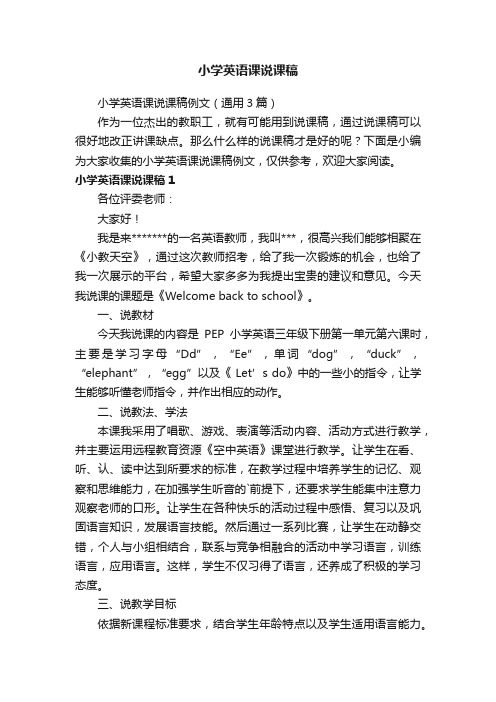
小学英语课说课稿小学英语课说课稿例文(通用3篇)作为一位杰出的教职工,就有可能用到说课稿,通过说课稿可以很好地改正讲课缺点。
那么什么样的说课稿才是好的呢?下面是小编为大家收集的小学英语课说课稿例文,仅供参考,欢迎大家阅读。
小学英语课说课稿1各位评委老师:大家好!我是来*******的一名英语教师,我叫***,很高兴我们能够相聚在《小教天空》,通过这次教师招考,给了我一次锻炼的机会,也给了我一次展示的平台,希望大家多多为我提出宝贵的建议和意见。
今天我说课的课题是《Welcome back to school》。
一、说教材今天我说课的内容是PEP小学英语三年级下册第一单元第六课时,主要是学习字母“Dd”,“Ee”,单词“dog”,“duck”,“elephant”,“egg”以及《Let’s do》中的一些小的指令,让学生能够听懂老师指令,并作出相应的动作。
二、说教法、学法本课我采用了唱歌、游戏、表演等活动内容、活动方式进行教学,并主要运用远程教育资源《空中英语》课堂进行教学。
让学生在看、听、认、读中达到所要求的标准,在教学过程中培养学生的记忆、观察和思维能力,在加强学生听音的`前提下,还要求学生能集中注意力观察老师的口形。
让学生在各种快乐的活动过程中感悟、复习以及巩固语言知识,发展语言技能。
然后通过一系列比赛,让学生在动静交错,个人与小组相结合,联系与竞争相融合的活动中学习语言,训练语言,应用语言。
这样,学生不仅习得了语言,还养成了积极的学习态度。
三、说教学目标依据新课程标准要求,结合学生年龄特点以及学生适用语言能力。
第六课时的教学目标是:1、通过远程教育资源以及其他不同方式要求学生学会“Dd”,“Ee”两个字母以及“dog”,“duck”,“elephant”,“egg”的正确认读。
2、以培养学生兴趣为根本出发点,运用《Let’s do》部分提高学生兴趣,让学生在玩中学,学中用。
3、培养学生积极主动学习以及运用语言的能力,提高他们的竞争意识,让学生在竞争中体现合作意识。
小学英语说课稿全英文
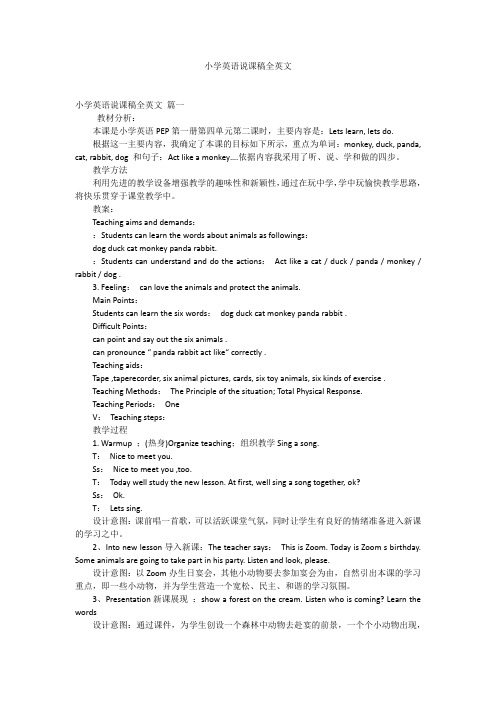
小学英语说课稿全英文小学英语说课稿全英文篇一教材分析:本课是小学英语PEP第一册第四单元第二课时,主要内容是:Lets learn, lets do.根据这一主要内容,我确定了本课的目标如下所示,重点为单词:monkey, duck, panda, cat, rabbit, dog 和句子:Act like a monkey….依据内容我采用了听、说、学和做的四步。
教学方法利用先进的教学设备增强教学的趣味性和新颖性,通过在玩中学,学中玩愉快教学思路,将快乐贯穿于课堂教学中。
教案:Teaching aims and demands::Students can learn the words about animals as followings:dog duck cat monkey panda rabbit.:Students can understand and do the actions:Act like a cat / duck / panda / monkey / rabbit / dog .3. Feeling:can love the animals and protect the animals.Main Points:Students can learn the six words:dog duck cat monkey panda rabbit .Difficult Points:can point and say out the six animals .can pronounce “ panda rabbit act like“ correctly .Teaching aids:Tape ,taperecorder, six animal pictures, cards, six toy animals, six kinds of exercise .Teaching Methods:The Principle of the situation; Total Physical Response.Teaching Periods:OneV:Teaching steps:教学过程1. Warmup ;(热身)Organize teaching;组织教学Sing a song.T:Nice to meet you.Ss:Nice to meet you ,too.T:Today well study the new lesson. At first, well sing a song together, ok?Ss:Ok.T:Lets sing.设计意图:课前唱一首歌,可以活跃课堂气氛,同时让学生有良好的情绪准备进入新课的学习之中。
小学英语教案说课稿(优秀6篇)
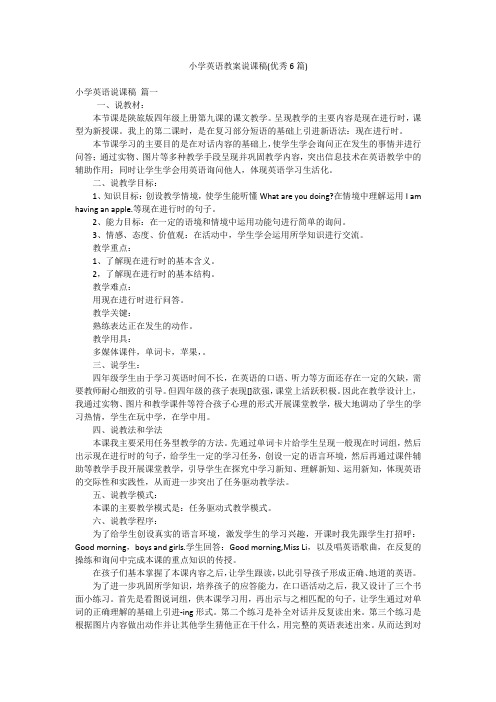
小学英语教案说课稿(优秀6篇)小学英语说课稿篇一一、说教材:本节课是陕旅版四年级上册第九课的课文教学。
呈现教学的主要内容是现在进行时,课型为新授课。
我上的第二课时,是在复习部分短语的基础上引进新语法:现在进行时。
本节课学习的主要目的是在对话内容的基础上,使学生学会询问正在发生的事情并进行问答;通过实物、图片等多种教学手段呈现并巩固教学内容,突出信息技术在英语教学中的辅助作用;同时让学生学会用英语询问他人,体现英语学习生活化。
二、说教学目标:1、知识目标:创设教学情境,使学生能听懂What are you doing?在情境中理解运用I am having an apple.等现在进行时的句子。
2、能力目标:在一定的语境和情境中运用功能句进行简单的询问。
3、情感、态度、价值观:在活动中,学生学会运用所学知识进行交流。
教学重点:1、了解现在进行时的基本含义。
2,了解现在进行时的基本结构。
教学难点:用现在进行时进行问答。
教学关键:熟练表达正在发生的动作。
教学用具:多媒体课件,单词卡,苹果,。
三、说学生:四年级学生由于学习英语时间不长,在英语的口语、听力等方面还存在一定的欠缺,需要教师耐心细致的引导。
但四年级的孩子表现[]欲强,课堂上活跃积极。
因此在教学设计上,我通过实物、图片和教学课件等符合孩子心理的形式开展课堂教学,极大地调动了学生的学习热情,学生在玩中学,在学中用。
四、说教法和学法本课我主要采用任务型教学的方法。
先通过单词卡片给学生呈现一般现在时词组,然后出示现在进行时的句子,给学生一定的学习任务,创设一定的语言环境,然后再通过课件辅助等教学手段开展课堂教学,引导学生在探究中学习新知、理解新知、运用新知,体现英语的交际性和实践性,从而进一步突出了任务驱动教学法。
五、说教学模式:本课的主要教学模式是:任务驱动式教学模式。
六、说教学程序:为了给学生创设真实的语言环境,激发学生的学习兴趣,开课时我先跟学生打招呼:Good morning,boys and girls.学生回答:Good morning,Miss Li,以及唱英语歌曲,在反复的操练和询问中完成本课的重点知识的传授。
小学英语英文版说课稿通用3篇
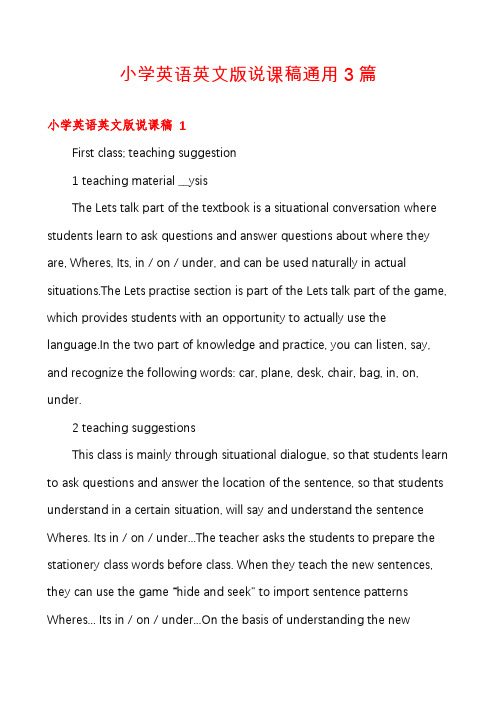
小学英语英文版说课稿通用3篇小学英语英文版说课稿 1First class; teaching suggestion1 teaching material __ysisThe Lets talk part of the textbook is a situational conversation where students learn to ask questions and answer questions about where they are, Wheres, Its, in / on / under, and can be used naturally in actual situations.The Lets practise section is part of the Lets talk part of the game, which provides students with an opportunity to actually use the language.In the two part of knowledge and practice, you can listen, say, and recognize the following words: car, plane, desk, chair, bag, in, on, under.2 teaching suggestionsThis class is mainly through situational dialogue, so that students learn to ask questions and answer the location of the sentence, so that students understand in a certain situation, will say and understand the sentence Wheres. Its in / on / under...The teacher asks the students to prepare the stationery class words before class. When they teach the new sentences, they can use the game “hide and seek" to import sentence patterns Wheres... Its in / on / under...On the basis of understanding the newsentence patterns, use the courseware to learn the new dialogue, so as to recognize the words in the class.Finally, once again, through the game, tin and consolidate the content of the Lets talk, the game can be divided into collective and group game game two, and will find stationery extended to find toys or other things around.Second hours teaching suggestion1 teaching material __ysisThis session is divided into two sections: Lets, learn, and Lets play.The Lets learn section focuses on teaching a few words that represent transport: bus, bike, jeep, taxi, and a preliminary understanding of the phrase "Look out".Lets play is part of the Lets talk part of the first class, to provide students with an opportunity to use language in real life.2 teaching suggestionsThe main lesson to learn several express transport words: bus, bike, jeep, taxi, students of these words have a preliminary understanding, learning again, teachers should design easy to mobilize the students interest and enthusiasm for learning activities.In the introduction of new classes, the introduction of new lessons with simple strokes, but also the use of real toys to allow students to perceive, to attract students with colorful pictures, with familiar voices to mobilize students.Then use animation courseware to present new knowledge.In the training session, the teacher may design the interesting activity, lets the student consolidatein the play, moves.Third hours teaching suggestion1 teaching material __ysisThis session includes two sections: Lets, say and Lets do.The Lets say part is to train students to listen, say, read and write letters Uu, Vv, Ww, and to make the students understand and speak the letters at the beginning of the word "umbrella", "under", "vest", "Violin", "window", "wind".The Lets do section reviews and consolidates the letter "A-W" through rhythmic, rhythmic instructions.And preliminary understanding of the list of action words show, point, type, colour, say, but also for students to provide a basis for language learning.A-T is the teaching content of this book Unit 1 through Unit 4.2 teaching methodsWhen teaching letters and words, the teacher uses letters, words and actions to present letters and words at the same time, so that students can learn on the basis of understanding the meaning of words.Such as: umbrella, vest, window, can be explained in kind; violin, wind explained by action.(according to students or teachers change the situation) understand the meaning of words, help to express words, more skilled reading words, and then learn letters, to master pronunciation, master letters shape.[Topic] Unit, Five, Where, is, my, ruler?[emphasis on teaching] everyday expressions Where s...And its It s in /on / under....[teaching difficulties] sentences: Where, is, my, car, In, the, toy, box, understanding[teaching aid preparation]1 the teacher prepares the tapes for teaching materials.2 teachers prepare Let s talk part of the courseware.3 teachers and students are ready for pen, pencil, ruler, eraser, bag and other stationery and car, toy, box, ball, plane, doll and other toys.4 teachers prepare cards and pictures of the words they learn.5 students prepare white paper and watercolor pen, ready to draw.6 students prepare patches for the group.[teaching process]1 warm up and review (Warm-up/Revision)(1) students practice everyday expressions.(2) games Show, me, the...Teachers or students say words such as "pencil", and teachers and students say Show, me, the, pencils., teachers and students put up pencils.In this way, practice other stationery words in the sameway.Teachers and students play games together to improve game effectiveness and munication between teachers and students.(3) the teacher plays the recordings of book Unit, 2, B, part Let, s, chant, and the students listen and clap and chant rhythmically.小学英语英文版说课稿 2Background of English teaching in primary school: It is not a long history that English is as a subject in primary school in our country and the main instructional aims of teaching English in primary school is to cultivate pupils’ basic abilities of their listening and speaking and their good sense of the English language. Our boys and girls are exposed to English for the first time, so it is very important to develop their keen interest in English.I. Contents:Today I’m going to talk about Part B of Unit 2, PEP Primary English, Book 3. This lesson includes two parts: Let’s talk and let’s practice. In section 1, it mainly deals with the dialogue about “What’s in the schoolbag?” and the answers. And in section 2, it provides a real situation for the Ss to prastise the pattern: How many +n.(pl.)+ do you have? And the answer: I have 23 +n.(pl.)II. Teaching aims1. Aims on the knowledge(1) To enable the Ss to understand and speak: “My schoolbag is heavy. What’s in it? Thank you sooooooo much.” Make sure that Ss can use these sentences in real situations.(2) To help Ss to finish the survey.(3) Let Ss finish the assessment of “Let’s check” in this unit.2. Aims on the abilities(1) To develop Ss’ abilities of listening and speaking.(2) To train the Ss’ ability of working in groups.(3) To foster Ss’ abilities of munication and their innovation.3. Aims on the emotion(1)To foster Ss’ consciousness of good co-operation and proper petition.(2) To lead Ss to show their loveliness to the poor.III. Key-points of this lesson(1) To help Ss ask and answer the question: What’s in it?(2) To enable Ss to study in groups and co-operate skillfully.(3) To develop Ss’ interest in English.IV. Difficult points(1) To help the Ss ask and answer the question “What’s in it?” and make sure they can use the plural nouns correctly.(2) To finish the survey by themselves.V. Teaching methodsAs we all know: the main instructional aims of learning English in primary school is to cultivate pupils’ basic abilities of l istening and speaking and their good sense of the English language. So in this lesson I’ll mainly use “Task-based” teaching method. That is to say, I will let the Ss learn in real situations, finish a task by making a survey to help the Ss to get a better understanding of the key structure of the dialogue. I willarrange four kinds of activities: singing, guessing game, finishing a survey and having a petition. And in this lesson a recorder, CAI, school things and a printed form will be needed. Students should prepare some school things.VI. Teaching procedures and purposes of my designing.I’ll finish this lesson in five steps.Step 1. Warm-up and preview1. Free talk between T and Ss about things in the classroom.2. Sing the song together: Books and pencils.3. Do some TPR, for example: Show me your English book. Show me your crayon.4. Review the numbers by asking: “How many crayons do you have?”Purpose: It is important to form a better English learning surrounding for the Ss by singing and doing some total physical response and at the same time it provides situations to review learned knowledge for the next step.Step 2. PresentationNow I’ll mainly talk about this step.1. Present the pattern: “My schoolbag is heavy.” “What’s in it?.”(1) Show a bag and say: “Look! I have a bag.” Carry it and say: “Oh, it is heavy. My schoolbag is heavy.” Help the Ss understand the meaning with the help of my body language. Then lead the Ss to read the sentence.Make sure they can say it correctly.(2) T: My schoolbag is heavy.Open the bag and say: “What’s in it? What’s in my schoolbag?”Take out a Chinese book. Then do the action again. Let the Ss read the sentence.2. Play a guessing game. Divide the whole class into four groups to have a petition.Let them guess: What’s in the bag? How many? Purpose: To present the key structures one by one is much easier for the Ss to learn and grasp the meanings. Proper petition can arouse the Ss’ interest in Englis h learning.3. With the help of the CAI to present the dialogue. Set a situation to help Ss understand: Two Ss are ing. One girl is carrying a heavy bag on her back. They are talking.Girl: My schoolbag is heavy.Boy: What’s in it?Girl: 20 story-books, 32 pencil, 9 rulers, 12 crayons and 30 picture-books. Etc.Boy: What will you do?Girl: They are for the poor.Boy: Great! I’ll bring some school things too.The boy es back home and puts a lot of things into the bag. Then hegoes to school again and gives them to a teacher. While he is taking them out, he is counting the numbers of all things. The teacher says: Thank you soooooooo much.4. Mention that we should take care of the poor.5. Play the cassette. Let the Ss listen and imitate the dialogue.Pay attention to their pronunciation and intonation. Purpose: CAI can provide a real situation for the Ss to understand the dialogue and the relationships between people better. Tell the Ss we should show our loveliness to the Ss.Step 3. PracticeDivide Ss into groups of six children. Each one would finish the printed form by asking and answering: How many storybooks do you have? Find out which group finishes faster. Story books picture-books sharpeners crayons pencils erasers pencil-cases rulers Chen Jie 8 24 3 32 26 4 1 3 Purpose: Task-based teaching method is used here to develop Ss’ ability of munication and also their ability of co-operation will be well trained.Step 4. AssessmentHelp Ss finish “Let’s check” of this unit and workbook.Purpose: To check the knowledge Ss have learned in this period.Step 5. Add-activity1. Let Ss tell each other how many school things they have after class.Tell their parents how many school things they have at home.2. Take care of everything they have.Purpose: Revision is so important that Ss should speak English as much as they as in class or after class. It is necessary for the Ss to do some extensive exercises after class to consolidate the knowledge they learned. 小学英语英文版说课稿 31. content of teaching materialsThis section focuses on festivals and focuses on how people usually spend their holidays.This class requires students to master the National, Day, Halloween, Christmas, Spring, Festival and What do people usually do at of...I?...And free to talk about how to spend the holidays.In this class, did leads to general questions and answers as well as new ones.Because the past tense of the be verb has appeared in the first third units, it is easier for the students to master it when they are studying.2. status of teaching materialsThe selected course in this class is English 6A Unit 6 in Oxford primary school.The teaching of this unit revolves around festivals.In this section of the festival, students have the knowledge of the previous third units foreshadowing, relatively easy to depth and expansion.This arrangement reflects not only the progressive meaning of teaching materials, but also the students knowledge level and cognitive level.On how people spend their holidays, especially in Western festivals,.Students are required tocollect information in time after class.In the actual teaching, this class uses the old topic, first teaches the new sentence pattern, and uses the sentence pattern to lead the new knowledge way to unfold, this is advantageous for the student to accept and grasp, also has manifested the teaching content the continuity.Say target:1. teaching objectivesThe new curriculum emphasizes the organic bination of knowledge and skills, process and method, emotion, attitude and values, and in the light of this understanding, I set the following teaching objectives: three.[Objective] to students cognitive spoken phrases and words: visit relatives and friends, go to parties, dress up in costumes, ware masks, make pumping lanterns, eat lots of delicious food, National Day, Christmas, Halloween, Spring, Festival, favourite; can use Whens s...What, do, people, usually, do, at...Did you?st...Yes, I, did./, No, I, didn, T. and so on.Ability to municate in English on holidays, and some students can introduce the festival in English fluently.[Objective] through activities and games, students are interested in learning English. Students are encouraged and willing to talk and participate actively in munication.And let students cultivate their sense of cooperation and petition in the process of learning.2. teaching difficultiesThe focus of teaching is to let students master the phrase, can use phrases to municate, the ability of students to use the phrase to describe the preliminary exercise Festival; difficulty is to enable students to understand the temporal changes in richness and realize the use of different phrases to create language.Doctrine of teaching:1. teaching method designAccording to the characteristics of this English class itself and the sixth grade students interest, I through the design of a specific image of the scene, the old with the new, continuous rolling knowledge, in order to disperse the difficulty of teaching, let students perceive and understand.At the same time, the creation of a number of tasks, from words to phrases to sentence to dialogue to pieces, make students practice and meaningful practice in multi exchange between teachers and students in learning, give full play to their enthusiasm, cultivate their ability to learn to use.2. learning method guidanceTo guide students through the method of parison, observation and speculation gradually new language project function, let the students in practice to realize multi-level learning English "use" the necessity, to encourage students to think actively, bold attempt.3. teaching meansAccording to the teaching content, teaching objectives, students age characteristics and psychological characteristics, in order to better stimulate students interest in learning, so as to actively participate in learning.Multimedia courseware, pictures and other teaching aids teaching, the abstract sentence in a vivid scene, the game, not only make the learning process more relaxed, can special case.Say process:1. warm up (Warm up)(1) announce the way of study in this lesson: group petition.The seats are divided into four teams, each of which is based on the class performance of each student. At the end of the class, WINNER is added.Then, begin "one sentence for each class". The sentences taught in this class are "Lite is long if you know how to use it.""[design intention] the announcement of the study style made the students full of interest in the lesson and aroused their fighting spirit and desire for the groups performance."One sentence for each class" is an essential part of every class I started in grade six.This section mainly teaches students some clever words and phrases.These sentences not only enrich students vocabulary, improve their expression ability, but also enable them to learn idiomatic expressions in english.So as to create a good atmosphere for learning english.2. take the old with the new [lead in]Provide topic Birthday, free munication between teachers and students, and then use the "How do you your birthday spend" to draw the new sentence pattern of this lesson "What do you on your birthday do", and then import "Did you"..."Last birthday?" and answer.Then use the Colour topic to elicit the sentence pattern My favourite....[design intention] to get rid of new knowledge through old knowledge is one of my frequently used teaching methods.With new students, students can master the sentence patterns more easily.At the same time, bine the new sentences with the old ones.It helps to cultivate students open thinking ability.。
小学英语说课稿模板(共6篇)
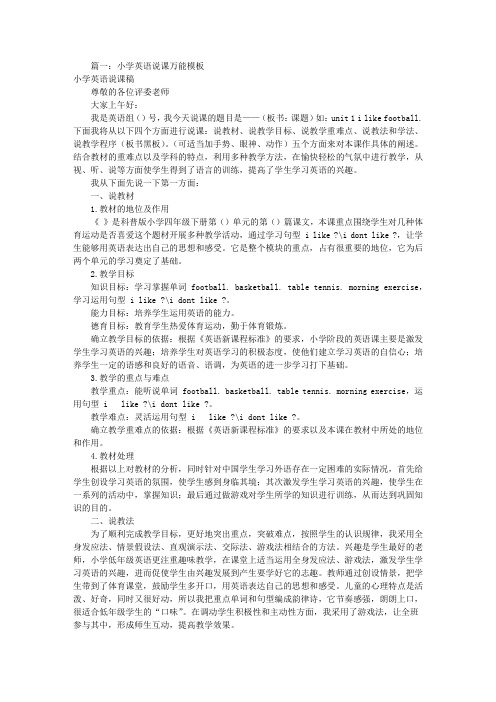
篇一:小学英语说课万能模板小学英语说课稿尊敬的各位评委老师大家上午好:我是英语组()号,我今天说课的题目是——(板书:课题)如:unit 1 i like football.下面我将从以下四个方面进行说课:说教材、说教学目标、说教学重难点、说教法和学法、说教学程序(板书黑板)。
(可适当加手势、眼神、动作)五个方面来对本课作具体的阐述。
结合教材的重难点以及学科的特点,利用多种教学方法,在愉快轻松的气氛中进行教学,从视、听、说等方面使学生得到了语言的训练,提高了学生学习英语的兴趣。
我从下面先说一下第一方面:一、说教材1.教材的地位及作用《》是科普版小学四年级下册第()单元的第()篇课文,本课重点围绕学生对几种体育运动是否喜爱这个题材开展多种教学活动,通过学习句型 i like ?\i dont like ?,让学生能够用英语表达出自己的思想和感受。
它是整个模块的重点,占有很重要的地位,它为后两个单元的学习奠定了基础。
2.教学目标知识目标:学习掌握单词 football. basketball. table tennis. morning exercise,学习运用句型 i like ?\i dont like ?。
能力目标:培养学生运用英语的能力。
德育目标:教育学生热爱体育运动,勤于体育锻炼。
确立教学目标的依据:根据《英语新课程标准》的要求,小学阶段的英语课主要是激发学生学习英语的兴趣;培养学生对英语学习的积极态度,使他们建立学习英语的自信心;培养学生一定的语感和良好的语音、语调,为英语的进一步学习打下基础。
3.教学的重点与难点教学重点:能听说单词 football. basketball. table tennis. morning exercise,运用句型 i like ?\i dont like ?。
教学难点:灵活运用句型 i like ?\i dont like ?。
确立教学重难点的依据:根据《英语新课程标准》的要求以及本课在教材中所处的地位和作用。
小学英语说课稿(精选10篇)
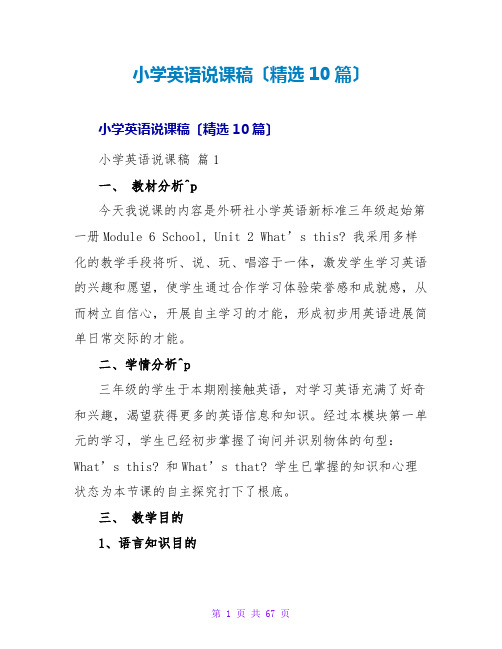
小学英语说课稿〔精选10篇〕小学英语说课稿〔精选10篇〕小学英语说课稿篇1一、教材分析^p今天我说课的内容是外研社小学英语新标准三年级起始第一册Module 6 School, Unit 2 What’s this? 我采用多样化的教学手段将听、说、玩、唱溶于一体,激发学生学习英语的兴趣和愿望,使学生通过合作学习体验荣誉感和成就感,从而树立自信心,开展自主学习的才能,形成初步用英语进展简单日常交际的才能。
二、学情分析^p三年级的学生于本期刚接触英语,对学习英语充满了好奇和兴趣,渴望获得更多的英语信息和知识。
经过本模块第一单元的学习,学生已经初步掌握了询问并识别物体的句型:What’s this? 和What’s that? 学生已掌握的知识和心理状态为本节课的自主探究打下了根底。
三、教学目的1、语言知识目的(1) 让学生能听、说、认、读pen,pencil,book,bag等单词。
(2) 通过学习让学生纯熟掌握句型What’s this? 和What’s that?2、学习技能目的:(1) 能听懂Let’s do中的指令并做出相应动作,如Point to th e …(2) 根据图片或在场景下进展简单的英语交流和表达,培养学生灵敏运用所学知识进展交流的才能.3、情感态度目的(1) 通过学习活动,使学生有兴趣听、说英语,培养学生注意观察、乐于模拟的良好习惯和主动竞争的竟识。
(2) 让学生在鼓励性评价中树立学习英语的自信心。
(3) 通过小组活动培养学生合作交流才能,从而让学生意识到学习英语的重要意义。
(4)充分利用教材所提供的学习资,实现自由参与与创新,能主动与别人交流,并克制交流中的困难,使交际顺利进展。
四、教学重难点1、学习新单词 pen,pencil,book,bag ,能正确认读。
2、稳固已学句型:What’s this? 和What’s that? 并能用It’s a…作出相应的答复。
五、课前准备教具准备:课文录音;带单词的物品图片;实物pen,pencil,book,bag;魔法包;奖品(贴画)。
小学英语英文说课稿(共6篇)
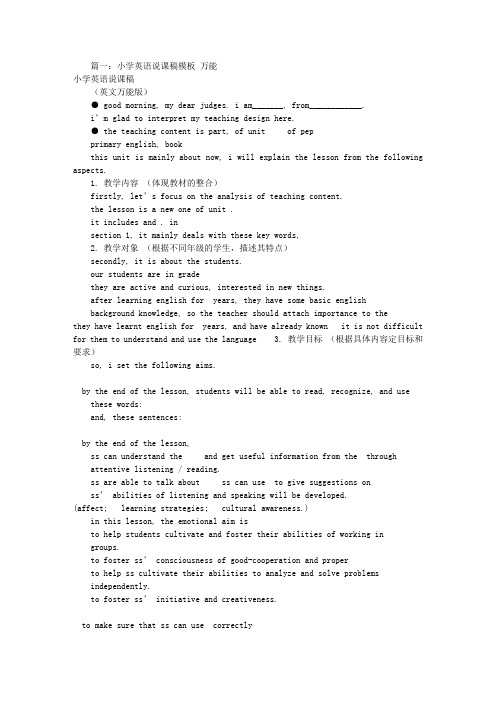
篇一:小学英语说课稿模板万能小学英语说课稿(英文万能版)● good morning, my dear judges. i am_______, from____________.i’m glad to interpret my teaching design here.● the teaching content is part, of unit of pepprimary english, bookthis unit is mainly about now, i will explain the lesson from the following aspects.1. 教学内容(体现教材的整合)firstly, let’s focus on the analysis of teaching content.the lesson is a new one of unit .it includes and . insection 1, it mainly deals with these key words,2. 教学对象(根据不同年级的学生,描述其特点)secondly, it is about the students.our students are in gradethey are active and curious, interested in new things.after learning english for years, they have some basic englishbackground knowledge, so the teacher should attach importance to thethey have learnt english for years, and have already known it is not difficult for them to understand and use the language 3. 教学目标(根据具体内容定目标和要求)so, i set the following aims.by the end of the lesson, students will be able to read, recognize, and usethese words:and, these sentences:by the end of the lesson,ss can understand the and get useful information from the throughattentive listening / reading.ss are able to talk about ss can use to give suggestions onss’ abilities of listening and speaking will be developed.(affect; learning strategies; cultural awareness.)in this lesson, the emotional aim isto help students cultivate and foster their abilities of working ingroups.to foster ss’ consciousness of good-cooperation and properto help ss cultivate their abilities to analyze and solve problemsindependently.to foster ss’ initiative and creativeness.to make sure that ss can use correctlyskillfully.to develop ss’ interest in english.the difficult point is:the pronunciation of 教法学法fourthly, it talks about teaching methods.andin this lesson, i will mainly use “task-based teaching method”,and so on.4. 教学过程①具体steps 根据具体内容定;②板书steps + purpose 说明;③如有可能,同时完成layout设计;next, let’s focus on the teaching procedures.i will finish the lesson in steps.it will cost about mins.after greeting with the ss, i will begin the lesson by singing the song together with the ss.purpose:the purpose of this is to form a better english learning surrounding forthe ss, and, at the same time, it provides situations to review the learnt knowledgefor the next step.it will cost about mins.with the help of the ppt, i set a situation of by to stimulate the ss’ interest of the lesson.by playing the ppt, iand then, (板书layout)the purpose of this is to present the new words and sentences in thesituation, which relates to the ss’ real life experiences, to help the ss understand the language easily and naturally.after presenting each new word (by the guessing game), i will impart theknowledge of pronunciation rules in teaching the new words.it is called phonics.it can facilitate the ss’ abilities to pronounce the words, and help them to remember the spelling of the words.(机械上口;有意义操练; let’s do; 课文对话表演;)it will cost mins, includingdue to the ss’ age, i make the purpose of this is to draw the whole ss’ attention to the spelling ofthe words.it is to help ss to learn through a true situation.in this step, i will give ss a free space to show their abilities.i willthen,used here.ability of cooperation will be well developed.making a new dialogue is to check if ss can use correctly and skillfully.(总结上课内容;德育渗透;作业布置;)in this step, i will guide the ss to conclude the key words and sentences and also, i will the purpose of this is to stimulate ss’ interest of learning english and5. 板书设计and, this is my layout design.that’s all for my teaching design. thank you a lot for listening. (gong) 篇二:小学英语说课稿:《what do you like》说课稿范文小学英语说课稿:《what do you like》unit 11 what do you like?说课稿1.说教材1.1教材内容本节教材的主要话题是food,功能为运用i like?.句型表达自己喜好什么食物,并在此基础上进行简单的语言交流。
小学英语说课稿(英文版)范例优秀9篇

小学英语说课稿(英文版)范例优秀9篇Step 1 Revision 篇一#160;#160; Get the students to give some animals’ names they know by asking the students the following question: Can you give us some names of different animals you know? This step is employed to revise the words related the animals. At the same time draw the students’ attention to the topic about animals.#160;#160; (V)TEACHING AIDS: 篇二Multi-media computer; OHP(overhead projector); tape recorder; software: Powerpoint or AuthorwareStep 2 Lead-in 篇三#160;#160; #160;Sign to the students to be quiet and close their books. Then start a free talk with the students. Use computer to show some pictures of different pets, such as dogs, cats etc. Ask the students several questions about raising pets. These questions are employed to warm up the students and raise the interests of the students to speak English in class on the topics they like and familiar with.Good morning, everyone!Today, I’ll say something about Unit 9 Part A in Book 4 of Oxford English.Background on the reformation of curriculum, this book can connect the life and act, emphasize the interest and experience of the Ss, the pictures are active and vivid. Grade four is the initial stage of English learning, so it stresses on the emotion of the Ss, creates a well beginning for the Ss. This Unit has 7 parts, we’ll learn Part A mainly, it embodies the repeating characterize. Review the learned language points “Where’s…”and the new language points will be represented in the following units. So this unit forms connecting links with a special meaning in this book.The content of this period is to use “Where’s\are…” to determine the place. And according to the contents and the fact of the Ss, I establish the following three teaching aims of this period: The first one: students can listen, read, say and spell the following words: a glass, a fridge, an egg, bread and a table.The second one: students can listen, read, say and write the following daily expressions: What’s for breakfast?Have some juice then.The third one: students can listen, read, say and write the following sentence patterns: Where’s\Where are the\my…It’s \They’re…There’s no …in \on \near…I think the most difficult point of this period is to make sure the students can use the patterns “Where’s\Where are…and There is no …in\on\near…” in their daily life correctly.And I will use some pictures, words and sentence cards, a tape recorder and the multi-media computer to help me achieve the aims.The task-based method, communicated method, group cooperate method will be used in this period.To accomplish the aims, I design the following steps:Ability#160; objects 篇四3. To improve students’ listening and speaking ability by reading and practising the dialogue.4. To develop students’ communicative ability by learning the useful expressions for making suggestions and replying.Step 4 Ss be the main body, T makes a guider. 篇五In class, Ss play as a host, and the T makes an influence on guiding, help Ss to act the learnt dialogue, it can stress the position of the Ss, and arouse their interest.Then I show a carton with no voice, ask Ss to make a dialogue in pairs.There are lots of ways to consolidate the new knowledge. Playing game is a good way. So according to the physiology of Ss, I hold a group competition during the game, ask Ss to finish the blanks. In this way can develop Ss’ good habits and achieve the aim of mastering the learned knowledge in situation.Step 3 Listen to the tape and Ss imitate to read and say. 篇六As the new reformation of curriculum, emphasized the traditional class attach importance to the mechanical teaching, neglect the experience and participation, for example, the five-step method. So in this lesson, after presentation, I ask Ss to listen to the tape with three Qs, read in different roles and in pairs, then try to recite the text.Step 1 Songs and the game arousers the emotion. 篇七In order to attract the Ss’ attention and construct an atmosphere of learning English, I let the students sing some English songs and play the game “Simon says”。
小学英语优质说课稿(精选8篇)

小学英语优质说课稿小学英语优质说课稿(精选8篇)作为一名老师,通常需要用到说课稿来辅助教学,说课稿有助于教学取得成功、提高教学质量。
我们该怎么去写说课稿呢?以下是小编帮大家整理的小学英语优质说课稿,希望能够帮助到大家。
小学英语优质说课稿篇1一、说教学内容今天我说课的内容是人民教育出版社出版的PEP Primary English Book IV Unit 6 At a Farm.的第一课时,主要学习sheep, lamb, goat, cow, horse, hen六个新词..二、说教材本节课是单词教学。
它是在孩子初步学习了句型“How many……do you have?之后进行教学的。
通过学习新词,感知句子What are they? They are….How many….为下节课的教学打下基础。
本课时容量大,但难度不大,并受到孩子的喜爱.三、说教学目标《英语课程标准》指出:激发和培养孩子学习英语的兴趣,使孩子树立自信心,养成良好的学习习惯和形成有效的学习策略,发展孩子自主学习的能力和合作精神是小学英语教学的基本任务。
在认真分析教材的基础上,我针对孩子实际,将本课时的教学目标及重,难点确定如下:1、知识目标(1)使孩子能听、说、认、读sheep, lamb, goat, cow, horse, hen等单词。
(2)初步感知:“What are they? They are…. How many….How many……”等句子孩子能听懂并理解其意思。
2、能力目标:(1) 能听懂Let’s do中的指令并做出相应动作.,如Shear a sheep.(2) 能区分农场的动物, 培养孩子灵活运用所学知识进行交流的能力.3、情感目标(1)培养孩子注意观察、认真模仿的良好习惯和主动竞争的竟识。
(2)激发孩子学习英语的兴趣,使孩子树立学习英语的自信心。
(3)培养孩子的合作交流能力。
四、说教学重点学习新词sheep, lamb, goat, cow, horse, hen, 能正确认读.。
小学英语教学说课稿5篇
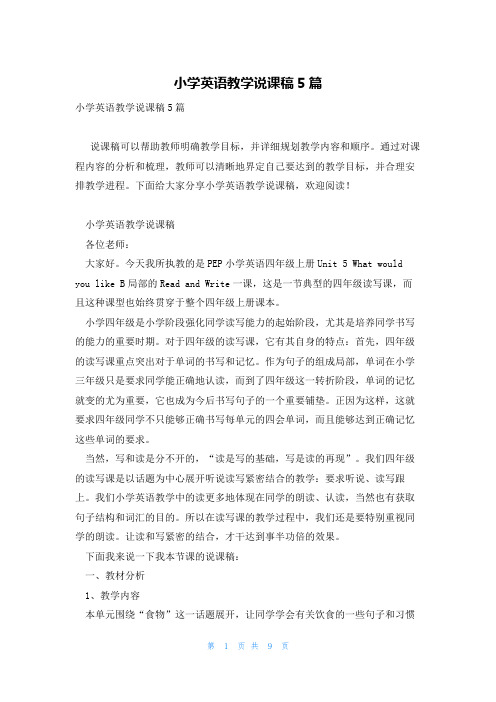
小学英语教学说课稿5篇小学英语教学说课稿5篇说课稿可以帮助教师明确教学目标,并详细规划教学内容和顺序。
通过对课程内容的分析和梳理,教师可以清晰地界定自己要达到的教学目标,并合理安排教学进程。
下面给大家分享小学英语教学说课稿,欢迎阅读!小学英语教学说课稿各位老师:大家好。
今天我所执教的是PEP小学英语四年级上册Unit 5 What would you like B局部的Read and Write一课,这是一节典型的四年级读写课,而且这种课型也始终贯穿于整个四年级上册课本。
小学四年级是小学阶段强化同学读写能力的起始阶段,尤其是培养同学书写的能力的重要时期。
对于四年级的读写课,它有其自身的特点:首先,四年级的读写课重点突出对于单词的书写和记忆。
作为句子的组成局部,单词在小学三年级只是要求同学能正确地认读,而到了四年级这一转折阶段,单词的记忆就变的尤为重要,它也成为今后书写句子的一个重要铺垫。
正因为这样,这就要求四年级同学不只能够正确书写每单元的四会单词,而且能够达到正确记忆这些单词的要求。
当然,写和读是分不开的,“读是写的基础,写是读的再现”。
我们四年级的读写课是以话题为中心展开听说读写紧密结合的教学:要求听说、读写跟上。
我们小学英语教学中的读更多地体现在同学的朗读、认读,当然也有获取句子结构和词汇的目的。
所以在读写课的教学过程中,我们还是要特别重视同学的朗读。
让读和写紧密的结合,才干达到事半功倍的效果。
下面我来说一下我本节课的说课稿:一、教材分析1、教学内容本单元围绕“食物”这一话题展开,让同学学会有关饮食的一些句子和习惯用语,如What would you like for dinner I d like…本课重点让同学掌握四个有关食物的四会单词rice,beef,fish,chicken。
这四个单词同学们在A局部的Let s learn中已经学过,因此我上课之前以歌曲和菜单的形式让同学复习一下本课的四会单词。
小学英语说课稿范文3篇

小学英语说课稿范文3篇小学英语说课稿范文3篇作为一位优秀的人民教师,总不可避免地需要编写说课稿,借助说课稿我们可以快速提升自己的教学能力。
说课稿要怎么写呢?下面是精心的小学英语说课稿范文,仅供参考,希望能够帮助到大家。
1.教材内容本节教材重点围绕节日展开,围绕人们经常如何度过节日展开话题。
本课时要求学生能掌握四个节日National Day, Halloween, Christmas, Spring Festival 及句型What do people usually do at ?.? I? .并能自由交流如何度过假日。
在本课中did引导的一般疑问句及回答也是新知之一。
因为在前面第三单元己出现了be 动词的过去式,所以学生在学习的时候这方面比较容易掌握。
2.教材的地位本节课所选的教学内容是牛津小学英语6A Unit 6。
本单元教学围绕节日展开。
在询问节日这部分,学生已有了前面第三单元的知识铺垫,比较易于深入与扩展。
这样的安排,既体现了教材循序渐进、由难到易的编排意思,又符合学生的知识水平和认知水平。
关于人们如何度过节日这一话题,特别是西方的节日,。
则需要学生课后及时收集资料。
在实际教学中,本课采用旧话题先教新句型,再用句型引新知的方式展开,这样既便于学生接受掌握,也体现了教学内容之间的连贯性。
1.教学目标新课程强调知识与技能、过程与方法、情感态度与价值观三个角度的有机结合,本着这样的认识,我制定如下教学目标。
[认知目标]学生能听、说、读短语及单词:visit relatives and friends , go to parties, dress up in costumes, ware masks , make pumping lanterns, eat lots of delicious food , National Day, Christmas, Halloween, Spring Festival , favourite ; 能运用 When’s ...? What do people usually do at ?? Did you?.last ?? Yes , I did./ No, I didn’t.等进行口语交际。
小学英语说课稿(6篇)
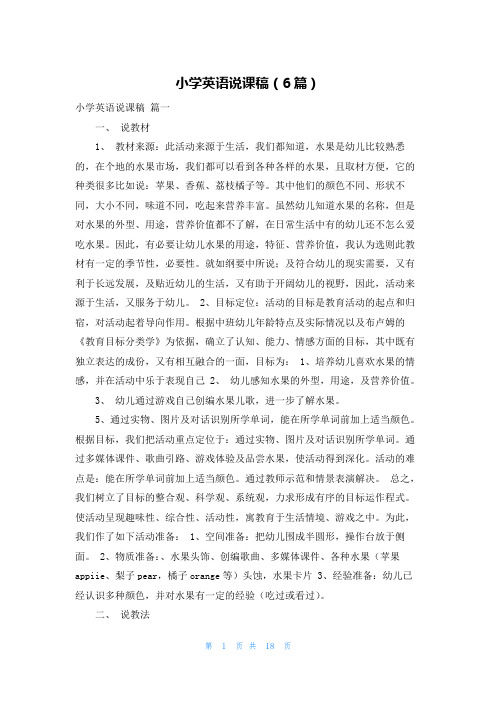
小学英语说课稿(6篇)小学英语说课稿篇一一、说教材1、教材来源:此活动来源于生活,我们都知道,水果是幼儿比较熟悉的,在个地的水果市场,我们都可以看到各种各样的水果,且取材方便,它的种类很多比如说:苹果、香蕉、荔枝橘子等。
其中他们的颜色不同、形状不同,大小不同,味道不同,吃起来营养丰富。
虽然幼儿知道水果的名称,但是对水果的外型、用途,营养价值都不了解,在日常生活中有的幼儿还不怎么爱吃水果。
因此,有必要让幼儿水果的用途,特征、营养价值,我认为选则此教材有一定的季节性,必要性。
就如纲要中所说;及符合幼儿的现实需要,又有利于长远发展,及贴近幼儿的生活,又有助于开阔幼儿的视野,因此,活动来源于生活,又服务于幼儿。
2、目标定位:活动的目标是教育活动的起点和归宿,对活动起着导向作用。
根据中班幼儿年龄特点及实际情况以及布卢姆的《教育目标分类学》为依据,确立了认知、能力、情感方面的目标,其中既有独立表达的成份,又有相互融合的一面,目标为: 1、培养幼儿喜欢水果的情感,并在活动中乐于表现自己 2、幼儿感知水果的外型,用途,及营养价值。
3、幼儿通过游戏自己创编水果儿歌,进一步了解水果。
5、通过实物、图片及对话识别所学单词,能在所学单词前加上适当颜色。
根据目标,我们把活动重点定位于:通过实物、图片及对话识别所学单词。
通过多媒体课件、歌曲引路、游戏体验及品尝水果,使活动得到深化。
活动的难点是:能在所学单词前加上适当颜色。
通过教师示范和情景表演解决。
总之,我们树立了目标的整合观、科学观、系统观,力求形成有序的目标运作程式。
使活动呈现趣味性、综合性、活动性,寓教育于生活情境、游戏之中。
为此,我们作了如下活动准备: 1、空间准备:把幼儿围成半圆形,操作台放于侧面。
2、物质准备:、水果头饰、创编歌曲、多媒体课件、各种水果(苹果appiie、梨子pear,橘子orange等)头蚀,水果卡片 3、经验准备:幼儿已经认识多种颜色,并对水果有一定的经验(吃过或看过)。
小学英语说课稿范文优秀10篇

小学英语说课稿范文优秀10篇【说教材】我说课的内容人教版三年级下册 unit 3 how many? 第二课时。
本课是功能型的交际训练课主要是让学生掌握和运用询问多少的句型:how many…… can you see? i can see …以及单词:eleven twelve thirteen fourteen fifteen。
【说教学目标】(一)语言知识目标1、使学生掌握询问多少的句型。
并且能在活动中灵活运用。
how many …can you see ?i can see….2、学习认读单词:eleven twelve thirteen fourteen fifteen.(二)语言技能目标1、使学生能够根据指令做动作。
2、根据图片、实物和情境说出单词和句子。
3、在图文或场景下进行简单的英语交流和表演。
(三)、情感态度目标1、通过本课学习使学生有兴趣听、说英语、背歌谣、参与游戏,勇于开口、乐于模仿。
(四)、化意识目标能够恰当的使用英语中询问多少的句型,了解英语国家中询问多少的方式。
【说重点难点】本课的重点是让学生掌握三会单词:eleven twelve thirteen fourteen fifteen和句型:how many …can you see?i can see ….本课的难点是读准名词复数的读音。
我主要通过感知新教材---设置---灵活运用着三个主要步骤来突破教材重难点。
【说教法】在教学中我主要运用就演示教学法和充分利用卫星资源及光盘教学法。
运用实物、图片等给学生一个直观的的形象,再加上远程资源和光盘的动画效果。
充分开发了学生的智力,提高学生对于学习英语的兴趣。
【说学法】1、模仿教学法---让学生跟着电视老师模仿。
这主要是利用了小学生模仿能力强的特点。
2、小组活动学习发---把全班分成小组,学生互相交流、切磋、共同完成学习任务。
在合作中感受学习英语的乐趣及交流的意义。
3、情景教学法---设置各种不同的情景,是教学活动带有浓厚的情感色彩,激发了学生想说的愿望。
小学英语说课稿(精选15篇)
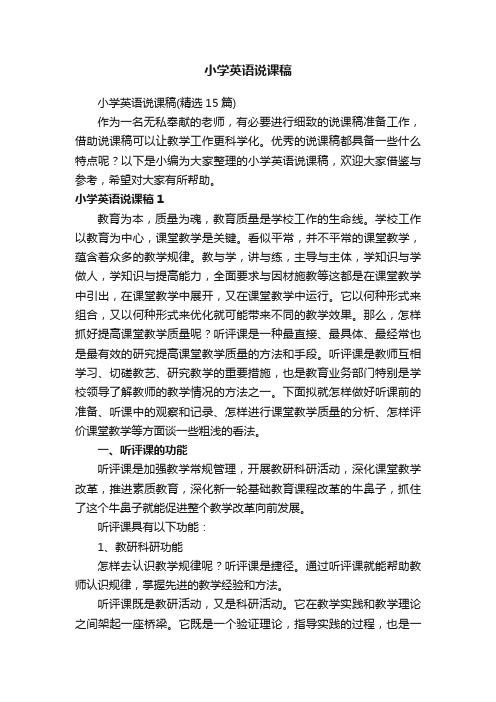
小学英语说课稿小学英语说课稿(精选15篇)作为一名无私奉献的老师,有必要进行细致的说课稿准备工作,借助说课稿可以让教学工作更科学化。
优秀的说课稿都具备一些什么特点呢?以下是小编为大家整理的小学英语说课稿,欢迎大家借鉴与参考,希望对大家有所帮助。
小学英语说课稿1教育为本,质量为魂,教育质量是学校工作的生命线。
学校工作以教育为中心,课堂教学是关键。
看似平常,并不平常的课堂教学,蕴含着众多的教学规律。
教与学,讲与练,主导与主体,学知识与学做人,学知识与提高能力,全面要求与因材施教等这都是在课堂教学中引出,在课堂教学中展开,又在课堂教学中运行。
它以何种形式来组合,又以何种形式来优化就可能带来不同的教学效果。
那么,怎样抓好提高课堂教学质量呢?听评课是一种最直接、最具体、最经常也是最有效的研究提高课堂教学质量的方法和手段。
听评课是教师互相学习、切磋教艺、研究教学的重要措施,也是教育业务部门特别是学校领导了解教师的教学情况的方法之一。
下面拟就怎样做好听课前的准备、听课中的观察和记录、怎样进行课堂教学质量的分析、怎样评价课堂教学等方面谈一些粗浅的看法。
一、听评课的功能听评课是加强教学常规管理,开展教研科研活动,深化课堂教学改革,推进素质教育,深化新一轮基础教育课程改革的牛鼻子,抓住了这个牛鼻子就能促进整个教学改革向前发展。
听评课具有以下功能:1、教研科研功能怎样去认识教学规律呢?听评课是捷径。
通过听评课就能帮助教师认识规律,掌握先进的教学经验和方法。
听评课既是教研活动,又是科研活动。
它在教学实践和教学理论之间架起一座桥梁。
它既是一个验证理论,指导实践的过程,也是一个实践操作、升华为理论的过程。
在听评课中可以学习吸收大量的教学理论、经验和先进的教改信息,在执教中去运用。
也可把自己的经验总结概括形成理论。
如此循环反复,教师的教学业务素质必然会有很大的提高。
听评课也是教育同行进行教材分析、教法与学法研究、教学经验交流的一种好形式。
小学英语全英说课稿(10篇)精选

小学英语全英说课稿(10篇)温馨提示:本文是笔者精心整理编制而成,有很强的的实用性和参考性,下载完成后可以直接编辑,并根据自己的需求进行修改套用。
小学英语全英说课稿第1篇:Part One Analysis of the Teaching Material(一) STATUS AND FUNCTION1。
This is an important lesson in Book One。
From this lesson, it starts asking the Ss to grasp contents of each Sample。
To attain four skills request of listening, speaking, reading and writing。
To start listing Word Bank and tell the Ss to remember the new words。
To start asking the Ss to write the English sentences well。
Therefore this lesson is in the important position of the teaching material。
2。
This lesson is the first one of Unit 2。
So if the Ss can learn it well, it will be helpful to make the Ss learn the rest of this unit。
3。
Such a topic is related to daily life, so it is helpful to raise learning interests of students and it will be also helpful to improve their spoken English。
小学英语说课稿模板6篇

小学英语说课稿模板6篇小学英语说课稿模板6篇说课稿的解释还需要对教学过程进行描述,包括引入活动、教学展开、教学方法和策略的运用等,以便听众或评委了解教学的具体实施过程。
现在随着小编一起往下看看小学英语说课稿模板,希望你喜欢。
小学英语说课稿模板精选篇1教材分析:我说课的内容是快乐英语第一册第五单元第三课时Let’s sing.本单元主要复习五中小动物(kitten,puppy,bird,chick,fish)两种新授小动物(dog and cat)和功能语句I want a(an)….,Come here,please.国家《英语课程标准》一级目标要求学生能交流简单的个人信息,表达简单的情感和感觉.二级目标要求学生能用简单的英语互致问候,交换有关个人,家庭和朋友的简单信息.培养学生从初学英语开始就能学着用英语去做事情的能力.根据课标要求,教材特点,我确立本课的教学目标为:1.语言知识目标:复习五种小动物的表达方法,学习两种新授动物的表达方法,学会如何向他人表达自己想要什么的方法,并做到语言准确,语调自然,说话有感情。
2.语言技能目标创设情境,在情境中学语言,培养学生运用语言的能力.3.情感态度目标培养学生学习英语的兴趣,激发他们学习的积极性.培养孩子乐于与人合作的意识,通过交流,加深对同学的了解.培养孩子热爱小动物的品质。
4,学习策略目标培养学生的注意力,观察力,激发学生积极思维通过游戏活动,培养学生对英语学习的兴趣,引导学生在任务中,积极运用所学英语进行表达与交流.教学重点:对单词cat和dog的教学,对功能语句Come here,please.的操练。
教学难点:能够灵活使用I want a(an)….来表达自己的意愿。
教具,学具准备:教具:7种小动物的图片,dog和cat的卡片,多媒体课件,5个信封学具:教材学情分析:学习本课之前,学生们已经在本单元的第一课时学习了5种小动物的表达方方法,在第二课时学习了I w ant a(an)…为学习本课打下了良好的知识基础。
小学英语说课稿范文(精选13篇)

小学英语说课稿范文(精选13篇)小学英语说课稿范文(精选13篇)作为一名优秀的教育工作者,时常要开展说课稿准备工作,认真拟定说课稿,那要怎么写好说课稿呢?以下是小编帮大家整理的小学英语说课稿范文,供大家参考借鉴,希望可以帮助到有需要的朋友。
小学英语说课稿篇1一、教材分析:本次说课我所使用的教材是义务教育课程标准实验教科书,小学三年级上册第二单元 Look at me 中的 Part B Lets learn 。
本套教材非常注重学生语言应用能力的培养,从学生的角度来讲,基础教育最主要的任务是要学会学习,开发自主学习能力,培养创新能力。
本教材在整体构思、内容安排、活动设计和教学方法都采用了与学生紧密联系的生活实际,真正体现了语言的交际功能,同时,它把知识和技能目标融会在了完成任务的过程之中,从而体现出了英语新课标提出的把话题———功能———结构———任务结合起来的总思路,为培养学生运用英语进行交流打下良好的基础。
这一单元的学习内容就是关于身体的各个部位名称的认识,所以,在教学中,我充分考虑到学生的需要,倡导任务型的教学方式,让学生通过活动,游戏,习得知识,易学乐学。
依据《英语课程标准》的要求,基础教育阶段英语课程的目标是以学生语言技能,语言知识,情感态度,学习策略和文化基础来培养学生英语综合语言运用能力,所以本课的教学目标设计如下:1、知识目标是让生能听说、认读单词:body,foot,leg,hand,finger,arm。
2、能力目标是能用英语介绍自己的身体的各个部位,如:This is my body…并能听懂所接触的指示语,能按照指令做出相应动作。
3、情感目标是激发和培养学生的学习英语的兴趣,使学生树立自信心,养成良好的学习习惯。
培养乐于助人的优秀品质,懂得和同伴交流,合作,从交流中获取更多的知识与快乐。
本课的教学重点:单词body,foot,leg,arm。
finger,hand 的听说认读。
- 1、下载文档前请自行甄别文档内容的完整性,平台不提供额外的编辑、内容补充、找答案等附加服务。
- 2、"仅部分预览"的文档,不可在线预览部分如存在完整性等问题,可反馈申请退款(可完整预览的文档不适用该条件!)。
- 3、如文档侵犯您的权益,请联系客服反馈,我们会尽快为您处理(人工客服工作时间:9:00-18:30)。
小学英文优秀说课稿
小学英文优秀说课稿
作为一名优秀的教育工作者,常常要写一份优秀的说课稿,借助说课稿可以更好地组织教学活动。
那么优秀的说课稿是什么样的呢?下面是小编为大家收集的小学英文优秀说课稿,仅供参考,欢迎大家阅读。
小学英文优秀说课稿1
一、说教材
(一) 教材地位、作用
本课内容是本单元的核心教学内容是“现在进行时”,主要学习句子Wh at are you doing ?I’m … .What is he/she doing? He/She is …. 本单元出现了八个单词,都是动词的现在进行时态今天这一课是第一课时。
所以今天的内容主要是呈现并操练八个单词,顺便结合句型进行交际活动。
(二) 教学目标
教学目标是教学活动的出发点和归宿,根据新课标以及大纲要求,结合以上分析,我确定本课的教学目标如下:
1、认知目标:
(1) 能正确听、说、读、写词汇playing shopping studying painting eating runningsleeping writing
(2)正确听、说、读、句型What are you doing ?I’m xxx .What is he/she doing? He/She is xx
2、能力目标:
(1)培养学生的观察力,分析能力。
(2)培养学生的创造能力、发展学生个性。
3、情感目标:
(1)激发学生的学习兴趣,提高学习的积极性。
(2)激发学生的参与意识,综合运用语言知识的意识,团结合作的意识。
(三)教学重点:
能正确听、说、读、写词汇playing shopping studying painting eating runningsleeping writing
(四)教学难点:
正确运用人称代词进行交流。
二、说教法、学法
爱因斯坦曾说过:“兴趣是最好的老师”.因此,英语教学一开始,就应当注意培养学生对这门学科的兴趣,保持强烈的好奇心和旺盛的求知欲。
这就要求我们教师采用灵活多样的教学法,激发学生的学习兴趣,充分调动他们学习的'积极性。
所以,我采用情景法、多媒体辅助教学法、交际法等进行教学。
1、情景法
2、情景法强调语言在情景中的应用,让学生身临其境地学习英语,使教学在生动活泼的情景中进行。
学生在轻松的情景下,容易学到知识与运用知识。
3、多媒体辅助教学法
多媒体辅助教学集图象、声音、文字于一体,使教学内容更生
4、动、形象,吸引学生的注意力,使其在轻松、愉快的氛围中接受新的知识。
5、交际法
学习英语,目的在于用英语进行交际。
英语要作为交际工具来教,也要作为交际工具来学,做到学用统一。
在教学中,我遵循这一原则,提供较真实的情景。
如:在引入新课时教师和一学生正在打篮球,让学生体会现在进行时,活学或用所学知识。
这样,激发了学生的学习兴趣,活跃了课堂气氛,又培养了学生的语言交际能力。
本堂课主要以现代化电教手段—多媒体辅助教学,贯穿整个教学过程。
增加了直观性和趣味性,加大了课堂密度,提高了教学效果。
我根据本堂课的教学目标、要求看图说出他/她/我在做什么,设计了生活化的情景,让学生在实际情景中运用所学知识。
同时通过多媒体的运用,设计各种小游戏,记忆看等多种形式的演练,让学生在玩中
学,乐中学。
三、说教学程序
Step1 Free talk
师生交流,既复习旧知,又很好地拉近了师生间的距离,为下面的合作学习打下基础。
Step 2 Lead in
首先教师和一学生在打篮球。
设计思路:每一堂课的开头很重要,要在上课一开始就吸引学生的注意力,调动他们的兴趣,这样便容易开展下面的内容。
学生都喜欢玩,看到老师在课堂上打篮球立刻会吸引学生的注意力,学唱歌曲迎合了儿童的心理需求,从而促使他们在轻松自如的情况下,主动地学习。
所以课前的预备活动,既活跃了课堂气氛,又缓解了学生的紧张情绪。
Step3、 Presentation
结合单词句型操练时,设计几个有竞赛的游戏,学生在玩游戏中既开心又可以巩固所学的单词和句型。
根据多媒体音、形、色、像图文并茂的优势,提供不同的时间,给学生创设了学习练说的机会,这样的练习,既保持了学生的学习积极性,又使学生体验到了知识收获后的满足。
Step 4、sing a song and finish activity
这一环节,根据儿童认知特点,学唱歌曲迎合了儿童的心理需求,从而促使他们在轻松自如的情况下,主动地学习。
歌词正好与所学的句型一致。
这一环节让学生在听、说、读方面得到练习、巩固. 培养学生良好的语音,语调和语感。
Step 5、播放FLASH动画
这一活动的设计,是对本课教学的有利巩固,学生都非常喜欢Gogo这个淘气的小生物和他的朋友们,学生学过的句型都在动画里出现,大部分学生都能看懂,学生见老师提出的问题自己能回答,使学生体验到了知识收获后的满足。
五、说板书设计
设计思路:
板书要求清晰、明了,体现教学的重点与难点,这里将本课的主要内容呈现在黑板上,同时这也有利于学生学习与运用对话。
小学英文优秀说课稿2
一、教学目标与要求
1、能听懂、会说:“I have a new water bottle. Can I see it? Sure. Here you are.” 并能在实际生活中运用。
2、能听说读单词storybook和water bottle。
3、学歌谣“I have a storybook . Me too.”
二、教学重、难点分析
重点:能听懂,会说:“I have ….”句型和单词storybook 和water bottle。
难点:在实际生活中运用“I have….”句型。
三、课前准备
1.教师准备挂图、玩具、文具等实物,VCD、录音机。
2、学生自备文具和自带一些小玩具
四、教学步骤和建议
1、热身(Warm-up)
(1)、教师与学生进行日常口语会话练习。
(2)、复习上学期所学句型“I have a ….”教师拿出一个玩具汽车并说“I have a new car.”把它递给学生让他来说“I have a new car.”拿出多个玩具练习这个句型,让每一个学生都说一遍。
2、新授(Presentation)
(1)、教师拿出一本故事书说“I have a new storybook.”,学生也拿出一本故事书说“I have a new storybook.”教师紧接着说“Can I see it.”学生答“Sure. Here you are.”和多个学生进行这个对话练习。
(2)、全班学生看本课VCD教学片。
(3)、通过观看教学片,在几遍后让学生试着跟读Just speak部分的内容。
(4)、学生跟读,教师纠正部分单词的发音。
(5)、学生分组分角色朗读,做到最快、最清晰、最大声。
(6)、请部分学生拿着水壶、故事书到前面表演对话。
(7)、去掉VCD的声音,让学生为教学片配音。
(8)、用图片展示生词storybook和water bottle,通过抢答游戏的方式让学生能听、说、读这两个单词,具体步骤如下:教师把图片快速从学生眼前闪过,然后学生举手抢答。
答对者奖励一个小贴纸。
(9)、让学生使用所学过的玩具或文具对Just speak部分的对话进行改编并表演出来。
例如:
A: Hi, ….I have a new doll.
B: Hi, …. I have a new ball.
A: Oh, cool. Can I see it.
B: Sure. Here you are.
A: Wow! Its super.
(10).听录音欣赏歌谣,在活跃的气氛中让学生跟着节奏学说歌谣。
五、巩固与延伸(Consolidation and extension)
1、打开质量监测完成对应的练习(教师给予一定的指导)。
2、家庭作业:跟读课文,朗读歌谣。
